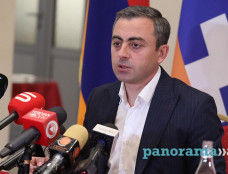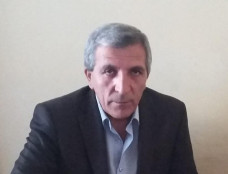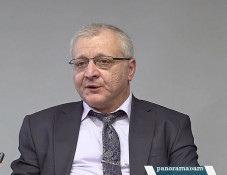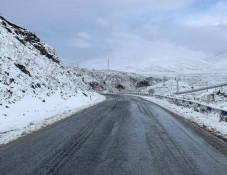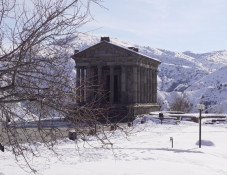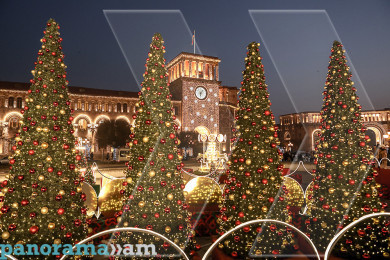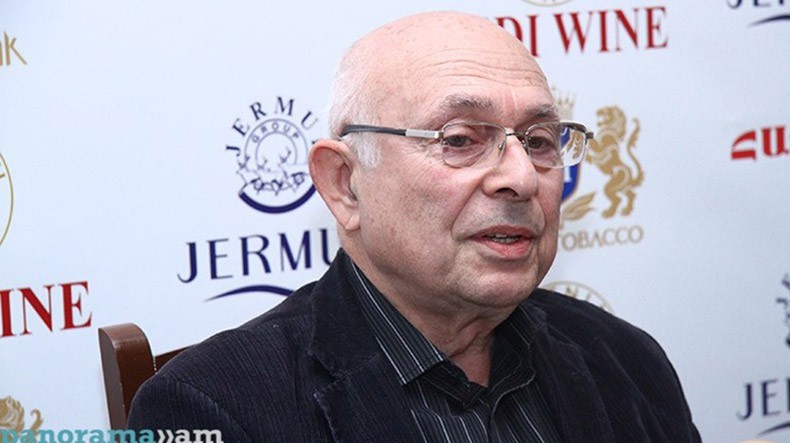
Rouben Galichian refutes Azerbaijani theory about ‘Armenians being newcomers’ to South Caucasus
None of the Islamic-period historians, even those living in the territory of the Azerbaijani Republic before the Soviet times, denied the Armenians’ presence in the southern Caucasus, namely, in the territory of Shirvan, Artsakh, Partav, Sheki, Shamkhor and neighbouring regions, according to the famous cartographer Rouben Galichian’s book Historical and Geographical Falsifications of Azerbaijan, a historical, cultural and cartographical research based on a detailed analysis backed by documentary evidence.
Galichian writes that the practice of denial of the fact began in Soviet Azerbaijan as a result of Stalin’s policy. “The rise of nationalism became a Soviet tradition, which has been practiced by the Azerbaijani historians and other specialists so far with even more fervour and use of modern propaganda means,” he writes.
In order to refute Azerbaijani claims regarding the Armenians as newcomers to the area lying to the south of the Caucasus mountains, Artsakh and in the territory of modern Azerbaijan, Galichian refers to mainly non-Armenian sources, which are judged to be unbiased, reliable and respected by all international academic circles and communities.
In particular, he analyses historical and geographical sources, including the travelogues, where Armenia, Albania and Azerbaijan are mentioned, as well as materials about the population of those countries and other data.
For a more substantive analysis, Galichian first presents in detail the dominating theses of the Azerbaijani ‘Armenians being newcomers,’ according to which the first Armenians were brought and settled in the region in the early 19th century by the Russian army and prior to this date, there had never been Armenians residing in the region.
Under the guise of specialist research, the propagandistic book War Against Azerbaijan ‘brings Azerbaijani fabrication to its apogee.’ As a ‘typical example,’ Galichian cites the following sentence from the book: “Although the Republic of Armenia does not have an ethnic Azerbaijani population now, its territory was a native land of Azerbaijanis long before the Armenians appeared there for the first time.” This is part of the continuous rhetoric repeated even by the president of Azerbaijan, Ilham Aliyev, in his New Year address to his nation in 2011, Galichian highlights.
According to him, a crucial point is that until the twentieth century there were no people calling themselves Azerbaijanis living in the territory north of the River Araks since prior to 1918 these people simply did not exist. The reality was that in Armenia, in addition to Armenians there were Tatars, Turks, Kurds and other minorities, as well as Persians and Iranian Azerbaijanis who were all able to move within the Iranian-controlled area without hindrance until the treaties of 1813 and 1828, when most of the Armenian territory, Karabakh and Zangezur was still under Iranian control.
“Adding to these were the Turkic people called ‘Caucasus Tatars’ who began to settle in the territory of Armenia. During the Soviet years the situation changed in favour of the population of the Republic of Azerbaijan, who were now called Azerbaijanis, and could still move at will to the fertile and easily accessible lands of Karabagh and Armenia,” Galichian writes.
Next, he highlights the Azerbaijani historians’ claim that the ‘process of the Armenians’ settling in the region apparently started in the 15th century with Vagarshabad (Echmiadzin), the first Armenian community in the Caucasus, and that the Armenians’ mass resettlement started in the 19th century from here.’
Galichian points out that the author has overlooked the fact that the monastery of Echmiadzin was founded during the fourth century, when Armenia became a Christian nation; Echmiadzin has been its religious centre ever since. During the fifteenth century Echmiadzin was not hardly established, as claimed in the book, but finally reaffirmed in 1441 as the seat of the Armenian religious leader, the Catholicos, after centuries-long absence of a permanent residence.
“One does not need to be a specialist to see that the ancient and medieval capitals of Armenia, Dvin, Artashat and Yervandashat, including major centres of religious learning have all been in the South Caucasus, north of the Arax River. Even during the pre-Christian era, the Armenian king Tigranes the Great (140-55 BCE) constructed one of its major fortress-cities, Tigranakert (‘City that Tigran Built’), in Eastern Artsakh, near the borders of Albania proper, with its Christian basilica built nearby during the fifth to sixth centuries,” he notes.
Galichian further refers to the Azerbaijani historians’ studies. Mirza Javanhsir Qarabaghi (1773-1853), whose History of Karabakh covers the period until 1830, writes about the Armenians of the region as the local population with no mention of their being newcomers. The same could be said about another local historian, Mirza Adigozel Beg (1780-1848), who claims in the prologue of his Karabakh-name, written in 1845, that ‘about certain occurrences I have referred to the elderly local Georgians, Armenians and Muslims.’
“A significant record documenting the presence of Armenians in Karabagh is the regional statistics gathered in 1823 by the order of General Aleksei Yermolov (Ermolov) (1777-1861), based in Tbilisi, who was the commander of the Russian forces in the Caucasus. The resulting figures were published in Tbilisi in 1866, containing the details of all the towns and villages with populations of Turks, Armenians, ‘nomads’ and others. The tables give the names of the town quarters, ethnic background of residents, names of the heads of the families and their taxes paid. These irrefutably prove the massive Armenian presence in the region prior to 1828-30,” Galichian writes.
As for the Azerbaijani thesis that after capturing the region in 1813 and 1828, ‘Russia achieved a considerable demographic change by resettling a great number of Armenians in the Azerbaijani territories,’ Galichian notes that the Azerbaijani historiographers refer to the reports prepared by the French-Russian historian and ethnologist Ivan Chopin (1798- 1870), who was consultant to the tax authorities in the Armenian Oblast of Russia. In order to make the data suitable for their claims, the Azerbaijani scholars omit many parts of the report, which do not suit their requirements. Concerning the Armenians, who arrived in the Armenian Oblast of Russia from Iranian Azerbaijan and Turkey after the Treaty of Turkmenchay, Chopin presents the following figures, which the Azerbaijanis keep silent upon: In total, 35,560 souls were resettled from Persia (23,458 in Yerevan; 10,652 in Nakhijevan and 1,340 in Ordubad), and 20,666 souls arrived from Turkey (20,639 in Yerevan and 27 in Nakhijevan).
Galcihian next refers to Chopin’s contemporary Sergei Glinka, another Russian historian, who states that the total number of Armenians resettled in Russia from Iranian Azerbaijan was around 40,000. According to Glinka’s collection of documents, published in Moscow in 1931, 750 Armenian families were transferred to Karabakh Oblast from Persia at the beginning of 1828. “It is worthy to note that the editor of these reports was Ilya Petrushevsky, a well-known anti-Armenian,” Galichia highlights.
Comparing the above-mentioned three sources, he concludes that around 4,500 Armenians were resettled in Karabakh Oblast and notes that the Armenian regions of Siunik and Artsakh were parts of that Oblast at the time.
Regarding the Armenians, who were resettled from the Russian-captured territories of the Ottoman Empire to the Russian Empire in 1829-1830, Galichian notes that 14,044 additional families (apart from the above-mentioned people), totalling up to 100,000 souls, were settled in the Russian Province of Tiflis, which included the modern regions of Shirak, Akhalkalaki and Akhaltsikhe.
When Azerbaijani scholars claim that there were no Armenians in the territory of the Azerbaijani Republic and Artsakh before 1828, they count the above families from the Ottoman Empire among the Armenians settled in the region of ‘Azerbaijan’ by the Russian troops.
Galichian writes that these scholars need to be reminded that during the first decade of the 17th century Shah Abbas of Persia deported some 300,000-400,000 Armenians from Armenia to Iran. Only 10 percent of their descendants managed to return home in 1828, after over two centuries of exile.
In the Azerbaijani arsenal is to be found another omnipresent ‘proof’: the photograph of a monument built by the local Armenians in 1978 in the Armenian village of Maragha, Martakert region. The inscription on the base of this monument says ‘Maragha—150’ commemorating the 150th anniversary of its founding. The Azerbaijani ‘scholars’ base all their claims on the argument that if that one village was established in 1828, then, prior to this date there were no Armenians living in the territory to south of the Caucasus mountains.
“The proponents of this contrived supposition disregard the myriad of references in western and eastern literature regarding the thousands of Armenians who lived in the territory of the present-day Republic of Azerbaijan, including Shamakhi, Shaki, Ganja, Shirvan and elsewhere, who were forcefully expelled during 1989-92 from what they considered as their hometowns and villages. Instead the Azerbaijani scholars base their claims on the population of just one village, which was destroyed by the Azerbaijani Omon forces in 1992,” Galichian points out and notes that on 10 April 2015, the Omon forces killed dozens of people and took many hostages.
He presents more convincing evidence for the Armenians’ presence in the South Caucasus – multitude of manuscripts written in the Armenian cultural religious centres of the region. “Up to the nineteenth century, many Armenian-language manuscripts were written in the big cities of the present-day Republic of Azerbaijan, some of which are now kept in the Matenadaran in Yerevan. They bear witness to the fact that in the past, cities such as Ganja, Shamakhi, Shaki and Baku had well-organised and developed Armenian communities which were able to support libraries and scriptoria, and which were producing manuscripts,” Galichian writes.
He presents a list of the manuscripts kept in just one centre, the Matenadaran, all prepared prior to 1820 and proving the existence of developed Armenian communities with rich cultural life in those cities. The figures indicate the manuscript reference number with its preparation date in brackets.
Ganja—3992 (1484), 8967 (1576), 9398 (16-18th cc.), 7980 (1639), 6771 (1667), 3541 (1671), 3576 (1673), 3994 (1683), 3044 (1779), 5234 (1783), 9517 (1819).
Karhat or Dashkesan—3196 (1655), 10044 (1656), 9448 (1665), 3856 (1669), 8965 (1675).
Shatakh, near Ganja—728 (1621), 713 (1636), 5072 (1661).
Shamakhi—8361 (1742), 8492 (1717-1720), 9729 (1765).
Shaki—4228 (1681), 4422 (1783).
Madrasa—5232 (1403).
Masaly—5997 (18th c).
Salyan—4013 (1803).
Baku—3853 (1779)
According to a research carried out by London University geneticists on the Y-chromosomes of male Armenians in the indigenous population of Siunik and Karabagh, there is a 20-25% frequency in their fundamental data, meaning that at least the same percentage of the forefathers of this section of society have been living in the area for at least 40,000 years, i.e. from Paleolithic times, Galichian writes.
Notably, the Azerbaijani authorities have refused to give permission for the same research to be carried out in the territory of the republic. Instead, they preferred to claim that the Armenians of Artsakh are the ‘armenicised brothers of the Albanians,’ Galichian writes.
To be continued.
Born in Tabriz, Rouben Galichian is a descendant of refugees from Van who survived the Genocide. He received scholarship and studied engineering at Aston University, Birmingham (UK). Since in 1981, he started to study the rich cartographical heritage in the libraries of the UK and other European countries. His first research, Historic Maps of Armenia (in English), was published in 2004. It was a collection of maps from various libraries and museums in the world, where Armenia was noted, beginning from the 6th century to the present times. His second book, Armenia in World Cartography, was published in Yerevan in 2005. The research ‘Countries South of the Caucasus in Medieval Maps. Armenia, Georgia and Azerbaijan’ (in English and Armenian) was published in 2007. The book The Invention of History (in English) was published in 2009.
In his book Historical and Geographical Falsifications of Azerbaijan, published in 2013, the author details the reasons, aims and methodology of the falsification of the history of Azerbaijan and the countries of the region.
Related news
- Rouben Galichian exposes myth of ‘divided Azerbaijan’ and Azerbaijani scientists’ falsifications of sources
- Rouben Galichian exposes Azerbaijani historiography’s contradictions to sources and even its own theories
- Rouben Galichian: Azari is Iranian dialect, Turkic language was introduced in region of in C11 with nomad Oghuzes
- Rouben Galichian: For Azerbaijani historians, issues of their people’s origin are flexible and alterable theories
- Rouben Galichian: Ziya Buniatov played key role in setting ground for conducting anti-Armenian propaganda in Azerbaijan
- Rouben Galichian: Falsification of Azerbaijan’s history begins from school textbooks and youth believes in that lie
- Historical and Geographical Falsifications of Azerbaijan. Rouben Galichian argues on aims of appropriating others’ history
Newsfeed
Videos







